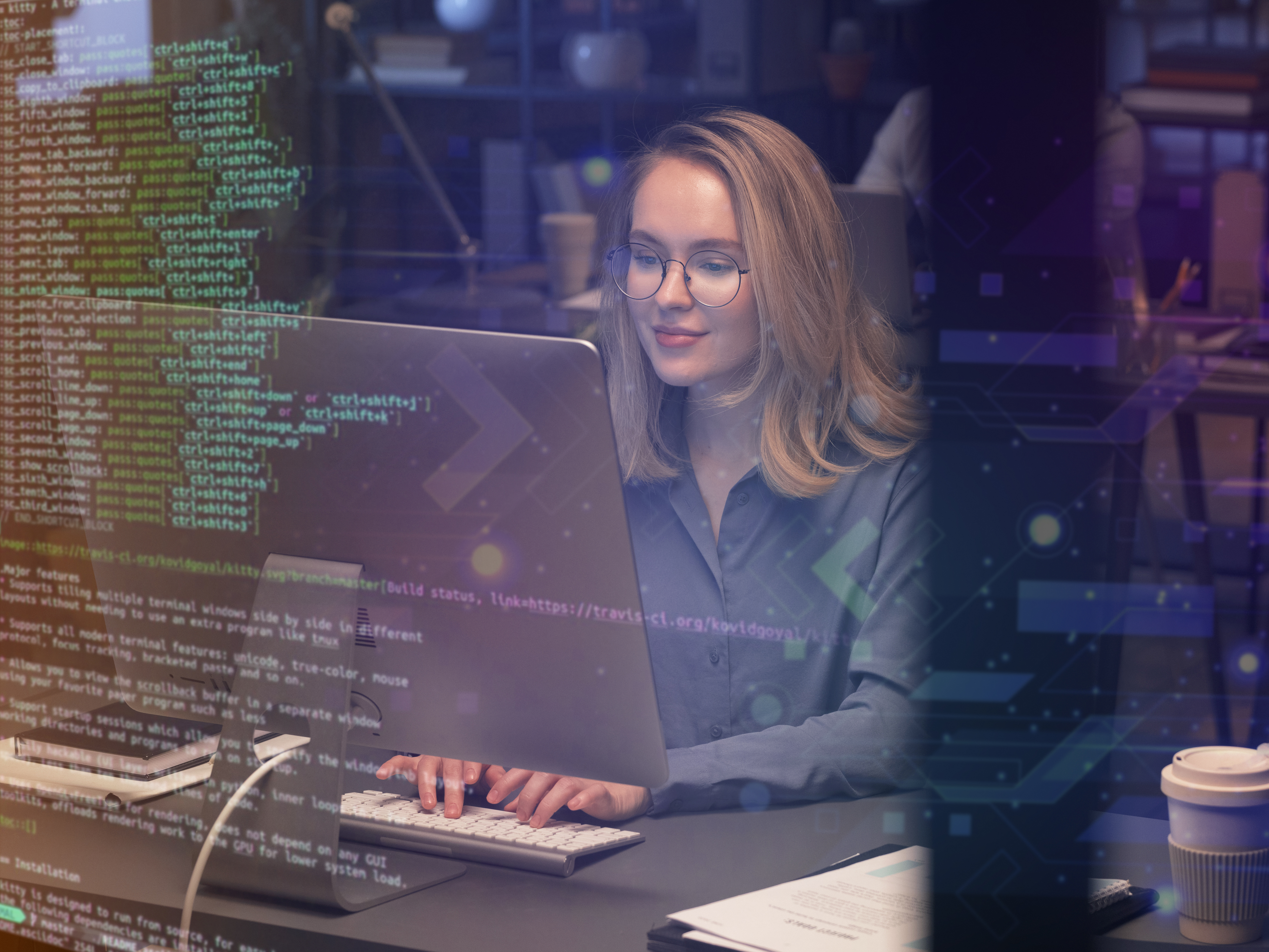The complex and precise area of software development manual code writing is an essential but daunting project characterized by its complexity. It requires a lot of effort and time from developers. In the past, creating software has been primarily based on manual processes and has often led to lengthy development times and complex work processes. However, the technology environment has seen a dramatic shift with the introduction of AI-Assisted Coding, a revolutionary innovation that is changing programming paradigms for software.
AI-assisted programming harnesses the potential of artificial intelligence and sophisticated machine learning algorithms to streamline code generation, offering many possibilities previously thought to be out of reach. The latest technology accelerates the work of making complex software by automating various tasks. It includes generating boilerplate codes, managing repetitive processes in the development process, streamlining, and reducing the complexity of manual programming.
The benefits of using an AI code assistant can be numerous and transforming, but managing the risks and opportunities associated with these devices is also crucial which is important for Custom Software Development Company to understand. The consequences of these issues profoundly impact both the developers and users, requiring a balanced, informed strategy for integration and usage. For example, reviewing code, an essential step in software development may naturally slow down the flow of the code to its final form. This can lead to significant delays, mainly if multiple pull requests are on the horizon or insufficient reviewers exist. These delays aren’t just process-related; they may also be extended into areas of inspection and feedback that require meticulous examination and thorough analysis.
This blog examines the new dimensions of AI-assisted programming, its transformative capabilities, and the difficulties and considerations associated with its integration within the software development process. We aim to present new insights and ideas that help us understand the significance and possibilities of AI-assisted programming in shaping and advancing software development.
What Exactly Is AI-Assisted Coding?
AI-assisted code is specially designed artificial intelligence software that creates or alters codes. It is designed to be an AI aid that is proficient in various programming languages. This software can assist coders and programmer writers write, troubleshoot, and improve their code without going by hand. Advanced machine learning (ML) models, including AI code generators, are taught to create code using data inputs from users who describe the language used in the code and what they would like it to accomplish. Code generation occurs quickly and relies upon the vast amounts of data from programming that are being fed into the AI model during training. The more reliable and accurate the information used to train the AI model is, the more secure and efficient it will be when writing code.
One of the significant problems with AI-generated content that incorporates code is whether it’s considered plagiarism. The term “written text” describes plagiarism when it duplicates or re-uses content taken from a source outside of the company without authorization or providing sufficient credit. Artificial intelligence-powered codes could be deemed plagiarism if they reproduce written by humans without proper credit. But, even though AI creates code using the patterns it has observed in actual codes and code, it also generates AI and only mimics the existing code.
As AI-generated content is still an entirely new idea, no clear guidelines exist. Also, ethical concerns are developing regarding how AI codes should be utilized exactly the same way as those written by humans. A few of the jobs that we could accomplish using AI-assisted code are the following:
Analysis Of Code
AI-assisted programming tools review the source code and identify its structure, patterns, and semantics. They will code in Abstract Syntax Trees (ASTs) to comprehend the hierarchical structure as relationships among the different components of the code. These tools also provide accurate analysis and understanding.
Generation And Completion Of Codes
These software tools can determine and produce pertinent code fragments or pages based on patterns learned and the context of use. They use probabilistic models to predict the most likely token next or sequence of tokens that can be found in the coding process, making it easier to code quickly and accurately.
Correction Of Error And Identification Of The Cause
AI-assisted coding can detect semantic and syntax errors by comparing code written against patterns learned and guidelines. It then suggests modifications or improvements to fix the issues identified while ensuring that it adheres to the best practices in coding and the latest standards.
Integration With The Development Environment
AI models are typically included in Integrated Development Environments (IDEs) or available as plugins that offer developers real-time help. At the same time, they code. They work in the background, analyzing the current work and making feedback and recommendations in the context. Thus, AI-assisted programming uses AI’s learning and analytical abilities to comprehend how to interpret, read, and write code. It also provides technical support to programmers in real-time while they deal with the challenges of programming languages and coding environments.
Benefits Of Using AI-Assisted Coding
There are various advantages to using AI tools to write or help you create and debug code. The benefits of AI programming will vary depending on your situation, your preference in language, and employers’ and clients’ desire to embrace it.
Increased Efficiency
The efficiency boost is among the main benefits of using AI to edit, write, and provide suggestions for code. AI and software work well for automated tasks and speed up the time to completion. AI programming using natural language processing allows developers to concentrate more on complex and innovative Custom Software Solutions development areas that computers cannot handle. Large amounts of code may be created quickly and depend on the computers for AI. AI lets software developers create more code without much effort or time.
Reduced Errors
Human beings aren’t immune to errors, even with years of experience, when performing their jobs in a specific area. AI models, however, are more likely to create errors while creating code, which reduces the number of errors that end up in the final output. In addition, AI algorithms are exceptional at recognizing patterns and irregularities within code that could indicate an issue or performance issue. They can also minimize the likelihood of making the same mistake to begin with. Developers can also use AI tools to identify and correct code mistakes more quickly than they would with a manual approach to diagnosing and troubleshooting.
Code Optimization
Another benefit of using AI is that it helps optimize the code. Programming languages are considered equally an art and a science. Code lines performing similar tasks may differ in length and difficulty based on the programmers’ chosen strategy. AI can automatically evaluate current code to discover where performance could be enhanced and recommend ways to improve it. It will produce better-performing, lighter, and highly-performing code.
Accessibility
The scripting language you choose will determine the time it takes to learn to code, anywhere from a few months to a few years. In addition, AI-aided coding could help make programming more accessible to those who do not have technical skills with a click of an icon.
With AI programming tools, people without programming experience can write simple programs that help automate and streamline their routine tasks. Also, you don’t have to rely on specialists to code the program starting from scratch.
Different Types Of AI-Assisted Programming Tools
Let’s take an overview of the various types of AI automated software for coding.
Toolkits For Code Completion
Tools for code completion use AI to anticipate and recommend the following line of code an author might write based on the situation of the code being written. They examine the syntax and meaning of the code written to give relevant and precise recommendations that reduce the chances of mistakes while increasing efficiency.
Debugging Tools
AI-powered debugging tools employ advanced algorithms that detect and fix mistakes in code automatically. They simplify the debugging process by pinpointing the cause of problems and suggesting suitable solutions. This reduces the amount of time and effort developers must put into troubleshooting.
Security Tools
Security tools powered by AI algorithms analyze the code to find and correct security flaws. They evaluate the code for known security vulnerabilities and offer suggestions to reduce the risk, which improves the software’s security.
Test Tools
AI-aided testing tools simplify the process of testing software. They use AI to conduct strict tests and identify performance problems and errors that may be obscure when developing. Automating the test procedure can ensure the program’s accuracy and performance.
Tools For Reviewing Codes
AI-assisted code review tools analyze the code for compliance with norms and guidelines, suggesting optimizations and improvements. They aid in maintaining code quality and adhere to the coding standard, ensuring the Custom Software Development Services are of excellent quality.
Code Generation Tools
The software uses AI to create codes or complete software based on the design or requirements. It assists in quickly translating concepts into functional code and speeds up the development process.
Optimization Tools
AI-powered optimization tools review the code and suggest enhancements and improvements. They assist in reworking the code to run faster, use fewer resources, and ensure that the software has been optimized to perform.
Every AI-assisted coding tool plays crucial roles in various phases of the development process and contributes to a higher level of software performance, security, and reliability.
When To Use AI-Generated Code
It is possible to balance the advantages and risks of using AI to create code by using it in suitable circumstances. AI is a highly flexible tool that can provide significant benefits in the right setting. However, it is best to limit the use of AI to automate repetitive programming tasks, speed up software development, or suggest code under the supervision of experienced developers. All in all, balancing AI assistance while preserving human coder skills remains essential. Too much reliance on AI can lead to declining abilities within the software development sector. Likewise, not paying attention to AI may cause you to fall behind your competition and peers.
Another important factor to consider is transparency. It’s crucial to reveal the utilization of AI generators and assistants during the coding process to prevent mistakes that could cause problems for clients or customers. This will help you deal with potential legal lawsuits.
Algorithm For Working Of AI-Assisted Coding Tool
AI-assisted tools for coding are at the crossroads of cutting-edge technology that seamlessly integrates Natural Language Processing (NLP), Machine Learning (ML), data analysis, and various other AI techniques that can transform the software development process.
Natural Language Processing & Machine Learning
NLP and ML are the foundation of AI-assisted programming tools. NLP allows these tools to recognize and interpret human languages inside the code. It also includes variables and comments, providing better comprehension of context and, consequently, more precise recommendations. ML algorithms, which have been trained on vast datasets containing various codes and patterns, let the tool adjust and learn to various styles of coding and preferences. It also ensures continuous improvements and a more customized experience.
The analysis is essential in operating coding in AI-codings that use OLs and can detect patterns, trends, and irregularities by studying vast quantities of data from code, which allows for accurate code prediction. They employ probabilistic models and statistical analysis to determine the most likely following line of code or block of code based on data analysis. This significantly decreases the coding process as well as minimizes the risk of making the chance of errors.
Integration Of Integrated Development Environments (IDEs)
AI-assisted programming tools are made to connect seamlessly with various IDEs and provide developers with instant assistance when they create codes. The integration allows developers to use the tools’ capabilities and features directly from their preferred IDE, improving their productivity and coding experience. This integration ensures that tools work seamlessly with the other tools for development and procedures, providing developers with comprehensive assistance.
Continuous learning and adaptive
One of the most distinctive features of AI-based coding instruments is their capacity to learn and improve continuously. The developers of these tools can learn from new code patterns and interactions with users, improving their predictions and suggestions. Continuous training ensures these tools are updated to the most recent trends in coding and developers’ preferences, providing ever-growing support for developers.
The complex working mechanisms of AI-assisted programming tools, which use NLP and ML techniques, data analysis, and seamless integration with IDEs, are transforming the world of software development. These tools are improving the coding experience and learning and evolving each time they interact, indicating that the combination of humans and AI intelligence could push the limits of software development.
The Limitations Of AI-Assisted Coding
AI-assisted programming has been recognized as a significant improvement in software development. It offers various advantages, such as automatic code generation and suggestion supply. However, awareness of the inherent risks and potential limitations is essential, especially regarding security and proper use.
Over Reliance And dependence
Though these tools are intelligent, they pose a threat to the over-reliance of developers on these tools. Artificial intelligence-assisted coding tools lack the capability to conceptualize and solve creative problems constrained by the restrictions of protocols and predefined parameters. The dependence on pre-established circumstances and lack of imagination prevent their ability to explore new solutions and think outside of the norms they have established. This ultimately results in a lack of breakthroughs in solving problems.
Security And Privacy Implications
AI-assisted programming tools require extensive access to codebases to provide valuable insights and recommendations that could pose risks to confidential or sensitive data. Incorporating such tools may inadvertently expose vulnerabilities in the source code, especially if the algorithm does not have proper training in secure programming techniques. Security and privacy concerns are essential to protect an organization’s interests and prevent data breaches.
Concerns Regarding Liability And Legality
The rapid growth of AI-assisted coding tools has also created legal confusion regarding who is responsible for security violations, errors, or discrepancies arising from AI-generated code. Liability could be a shared obligation between developers, AI tool providers, and associated software organizations, which requires clarity regarding the legal ramifications of accountability and liability when there are disagreements. Determining the extent of liability depends on the degree of involvement, dependence on code generated by AI, and particular conditions surrounding the questions.
Insufficient Creativity And Ingenuity
While they can be effective in code generation, AI-based programming tools must be equipped with the capacity to generate innovative ideas and solve problems. The developers must be aware of these limitations and remain within the limits of AI while maintaining an equilibrium between AI aid and human imagination.
In AI Models, Bias Is a Problem
The effectiveness and dependability of AI-assisted coding software are directly related to the diversity and quality of the data used for training. Biases and the absence of representation in the training data will reflect the program’s output and emphasize the need to carefully examine the source data for training to guarantee accuracy and diversity.
Limitations On Knowledge
Optimizing AI-assisted coding tools demands a deep knowledge of the techniques and technology. Without this understanding, developers could struggle to utilize all of AI capabilities. They may cause errors in code, highlighting the necessity to acquire a comprehensive understanding before using AI-assisted coding tools.
Although AI-assisted programming is undoubtedly changing the software development landscape, its inherent challenges and dangers require careful consideration and balanced integration. Recognizing and responding to these issues is vital to maximizing AI’s advantages, avoiding potential risks, and ensuring the security and accountability of this revolutionary technology.
Future Of AI-Assisted Coding
AI-assisted programming is leading the way in the paradigm shift in software development and is bringing about a new era of revolutionary innovations and trends. Here is a look at potential developments, their implications for the software development process, and the possible breakthroughs we could witness with AI-assisted programming.
Now, look at the recent developments and trends in AI-assisted coding.
Advanced Analytical Techniques That Can Predict The Future
Recent technological advancements in AI-assisted programming are based on advanced predictive analysis that can detect potential errors and recommend efficient solutions. This helps in reducing testing time and improving code quality.
Models For Enhanced Learning
AI models could see improvements, opening the door to more intelligent, context-based learning models. This allows us to comprehend different languages better and create more precise codes tailored to the specific needs of every project.
Expansive Language Support
The future is full of language support. AI-based programming tools can understand and produce code for various programming languages. Ultimately making them valuable tools in multi-language programming environments.
Collaborative AI Development
Collaboration in AI platform development could rise, allowing people worldwide to train and refine AI models. This would foster an AI-assisted approach driven by community code.
Conclusion
Artificial intelligence can be enormously beneficial to developers. Coding tools that use AI have transformed Software Product Development and brought benefits such as greater efficiency, improved precision in coding, and shorter learning curves. AI-assisted programming is a major technological advancement that is changing the future of software development through its vast possibilities and revolutionary capabilities. It goes beyond traditional code paradigms and promises a future in which software development is performed with supreme accuracy and efficacy. It is also a symbol of unmatched quality and creativity.
The journey of AI-assisted programming isn’t free of challenges. It demands a thorough knowledge of and a careful consideration of its weaknesses, such as the possibility of biases and security issues and the potential for excessive reliance. Navigating this exciting journey with the utmost caution, ethical responsibilities, and a commitment to ongoing learning and advancement is vital. AI-assisted coding is more than an instrument; it’s an indispensable companion in software development. It promotes a harmonious connection between human creativity and machine accuracy. It envisions a time when humans and technology come together to produce reliable, functional, innovative, and revolutionary software.
AI-assisted programming is shaping the technology of future software. It’s blending the world of possibilities with technology to redefine what is possible. It’s an ode to humanity’s creativity and technological innovation, opening the door to new frontiers and aspects of software development. In the end, AI-aided coding tools are exciting. However, to ensure the success of these tools, it is important to be aware of the risky scenarios and ensure that they align with moral principles.











